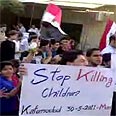
Syrians relive Hama massacre
Three decades after tens of thousands die in military crackdown ordered by Assad's father, city endures second massacre as security forces kill dozens of protesters. 'You cannot separate what happened in 1982 from what is happening now' says activist
A Syrian city that was bombed into submission three decades ago after a crushed uprising has become a new center for protest and violence, as activists said troops opened fire on a crowd of thousands in the city of Hama and killed at least 53.
Syrian opposition sources said the number of casualties was much higher than reported earlier, putting the death toll at 130.
In 1982, Hafez Assad's army crushed a Sunni uprising by the Brotherhood in Hama over a three-week period, flattening much of the city and killing 10,000 to 25,000 people, according to Amnesty International estimates.
"Today's protests are a reaction to the so-called overtures by the regime which has lost all credibility. It's the people saying we will not accept this anymore," said Najib al-Ghadban, a US-based Syrian academic and political activist.
Al-Ghadban said the Hama demonstration was especially significant, calling it "a qualitative leap that will encourage others to do the same."
He said most of the protesters were born after the 1982 massacre and do not harbor the same fear as their elders. "They heard about it, which is positive because it makes them more bent on keeping their protest movement peaceful. They don't want a repetition of the massacres."
"You cannot separate what happened in 1982 from what is happening now. It's the same trend, but of course the world has changed so it cannot be on the same scale," he said.
People nationwide poured on Friday into the streets in unprecedented numbers, defying the crackdown and a government chokehold on the Internet.
Syrian protester emotionally describes Hama shooting
In Hama, the witness and activists said at least 100,000 people took part in the protest, making it one of the largest in the city since the start of the 11-week uprising.
Rights groups say more than 1,100 people have been killed nationwide since mid-March.
"It is a real massacre," said a witness who took part in Friday's Hama protests and fled the gunfire. "People were running, shouting. We ran up to people's homes and hid there until the gunfire died down," he said.
The eyewitness in Hama said chaos broke out Friday as troops fired tear gas and live ammunition and snipers opened fire on tens of thousands of peaceful protesters who were calling for freedom and Assad's ouster.
"People started running while the dead littered the streets," he said. The activist, who like many involved in the protests requested anonymity to avoid reprisals, said hospitals were calling on people to donate blood.
A Syrian activist said authorities cut Internet service in several parts of the country, apparently to prevent activists from uploading footage of the protests and the government crackdown and from organizing new resistance. In Damascus, several people contacted over the phone said the Internet was down.
The government has cut Internet service in areas of military operations before and occasionally disrupted service, but Friday's outage appeared to be the most widespread.
Renesys, a trusted US firm that specializes in keeping tabs on Internet connectivity, confirmed the Syrian outage and said two-thirds of all Syrian networks were unavailable.
Still many activists found alternate ways to log on and upload videos, such as satellite connections.
- Follow Ynetnews on Facebook










